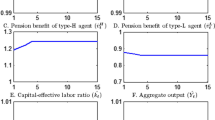Abstract
We study a potential rearrangement of the social security contributions that could ease the weight of the state as well as contribute to the economy’s growth. We investigate an approach that could fund the benefits promised through a pay-as-you-go scheme, by splitting the contribution made per individual in two parts; one that funds the difference between the liabilities and the assets for a certain period of time, and another that is directed to a funded scheme. After the predetermined time period, the full contribution goes to the funded scheme, which is anticipated to grow so that it will alleviate the burden of the state and will simultaneously allow the reinvestment of the accumulated funds. Such a reinvestment will return value, as the funded pension scheme will invest in state or corporate bonds and equity, of even small and medium enterprises, therefore contributing to the economy’s growth.
Access this chapter
Tax calculation will be finalised at checkout
Purchases are for personal use only
Similar content being viewed by others
References
Athens Exchange Group. 2015. “Monthly Statistical Bulletin Key Market Indices.” June. www.helex.gr
Bijlsma, Michiel, Casper van Ewijk, and Ferry Haaijen. 2014. “Economic Growth and Funded Pension Systems.” Netspar Discussion Papers, DP 07/2014-030.
Blackburn, John O. 1962. “Economic Aspects of Pension Plans, Law and Contemporary Problems.” Problems of the Aging 27(1): 89–101.
Bodie, Zvi. 1989. “Enhancing the Efficiency of Pension Plans, What is the Future for Defined Benefit Pension Plan, 101–111. Employee Benefit Research Institute, Washington DC.
Bodie, Zvi, Alan J. Marcus, and Robert C. Merton. 1988. Defined Benefit versus Defined Contribution Pension Plans: What are the Real Trade-offs, Pensions in the U.S. Economy, 139–162. National Bureau of Economic Research, University of Chicago Press.
Broadbent, John, Michael Palumbo, and Elizabeth Woodman. 2006. “The Shift from Defined Benefit to Defined Contribution Pension Plans – Implications for Asset allocation and Risk Management.” Bank for International Settlements.
Corsetti, Giancarlo, and Klaus Schmidt-Hebbel. 1995. “Pension Reform and Growth.” The World Bank Policy Research Department Macroeconomics and Growth Division, Policy Research Working Paper No. 1471.
Davis, Philip E. 2005. “The Role of Pension Funds as Institutional Investors in Emerging Markets.” Working Paper. http://bura.brunel.ac.uk/handle/2438/979
Davis, Philip E., and Yuwei Hu. 2008. “Does Funding of Pensions Stimulate Economic Growth?” Journal of Pension Economics and Finance 7(2): 221–249.
Demirgüç-Kunt, Asli, and Ross Levine. 1996. “Stock Markets, Corporate Finance, and Economic Growth: An Overview.” The World Bank Economic Review (A Symposium Issue on Stock Markets and Economic Development) 10(2): 223–239.
Forman, Jonathan B. 1999. “Public Pensions: Choosing between Defined Benefit and Defined Contribution Plans.” Law Review of Michigan State University, Detroit College of Law (1): 187–213.
Gompers, Paul, and Josh Lerner. 2001. “The Venture Capital Revolution.” The Journal of Economic Perspectives 15(2): 145–168.
James, Estelle. 1997. Mandatory Defined Contribution Accounts from an International Perspective, Retirement Prospect in a Defined Contribution World, 133–137. Employee Benefit Research Institute, Washington DC.
Jeng, Leslie A., and Philippe C. Wells. 2000. “The Determinants of Venture Capital Funding: Evidence across Countries.” Journal of Corporate Finance 6: 241–289.
Levine, Ross. 1997. “Financial Development and Economic Growth: Views and Agenda.” Journal of Economic Literature 35(2): 688–726.
Mayer, Colin, Koen Schoors, and Yishay Yafeh. 2005. “Sources of Funds and Investment Activities of Venture Capital Funds: Evidence from Germany, Israel, Japan and the United Kingdom.” Journal of Corporate Finance 11: 586–608.
Merton, Robert C. 1969. “Lifetime Portfolio Selection under Uncertainty: The Continuous-Time Case.” The Review of Economics and Statistics 51(3): 247–257.
Merton, Robert C. 1971. “Optimum Consumption and Portfolio Rules in a Continuous-Time Model.” Journal of Economic Theory 3: 373–413.
OECD. 2013. “Pension Markets in Focus.” www.oecd.org
OECD. “Funded Pensions Indicators.” OECD.StatsExctracts. stats.oecd.org
OECD. “Funded Pensions Indicators: Asset allocation.” OECD.StatsExctracts. stats.oecd.org
OECD. “Funded Pension Statistics.” OECD.StatsExctracts. stats.oecd.org
Office of the Superintendent of Financial Institutions. 2001. “Guideline for Converting Plans from Defined Benefit to Defined Contribution.” www.osfi-bsif.gc.ca
Rocholl, Jörg, and Taro Niggemann. 2010. “Pension Funding and Capital Market Development.” Working Paper. http://ssrn.com/abstract=1571126
Talmor, Eli, and Florin Vasvari. 2014. “The Extent and Evolution of Pension Funds Private Equity Allocations.” The Adveq Applied Research Series, Coller Institute of Private Equity at London Business School. www.collerinstitute.com
Pensions Europe. 2015. “How Pension Funds Contribute to Jobs and Growth in Europe – And How to Strengthen their Participation in the Capital Markets Union.” www.pensionseurope.eu
Texas Pension Review Board. 2012. “A Review of Defined Benefit, Defined Contribution, and Alternative Retirement Plans.” Research Paper No. 12–001.
Utah Retirement Services. 2007. “Conversion from a Defined Benefit Plan to Defined Contribution Plan Issues.” Paper. myuea.org
VanDerhei, Jack, Craig Copeland, and Dallas Salisbury. 2006. “Retirement Security in the United States – Current Sources, Future Prospects, and Likely Outcomes of Current Trends.” Employee Benefit Research Institute, Washington DC.
World Bank. “Data by Country.” Data available at worldbank.com
Zandberg, Eelco, and Laura Spierdijk. 2013. “Funding of Pensions and Economic Growth: Are They Really Related?” Journal of Pensions Economics and Finance 12(2): 151–167.
Acknowledgments
This research has been co-financed by the European Union (European Social Fund—ESF) and Greek national funds through the Operational Program "Education and Lifelong Learning" of the National Strategic Reference Framework (NSRF)—Research Funding Program: THALES. Investing in knowledge society through the European Social Fund.
Author information
Authors and Affiliations
Editor information
Editors and Affiliations
Copyright information
© 2016 The Author(s)
About this chapter
Cite this chapter
Poufinas, T., Kouskouna, E. (2016). Rearranging Social Security Contributions: Alleviating the Burden of the State and Returning Value to the State and Society. In: Petrakis, P. (eds) A New Growth Model for the Greek Economy. Palgrave Macmillan, New York. https://doi.org/10.1057/978-1-137-58944-6_13
Download citation
DOI: https://doi.org/10.1057/978-1-137-58944-6_13
Published:
Publisher Name: Palgrave Macmillan, New York
Print ISBN: 978-1-137-58943-9
Online ISBN: 978-1-137-58944-6
eBook Packages: Economics and FinanceEconomics and Finance (R0)




